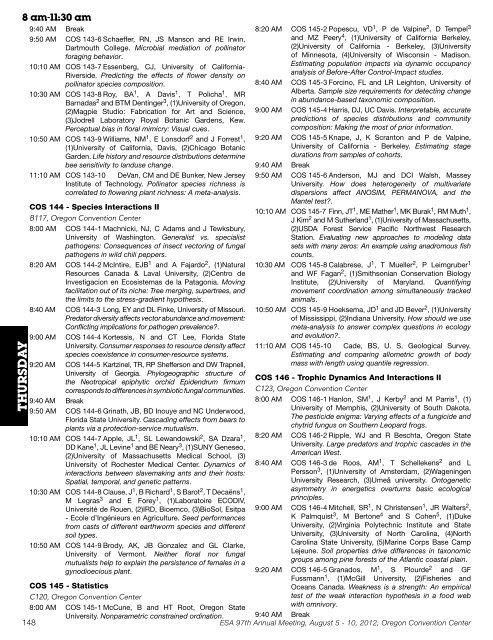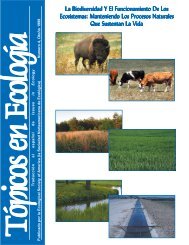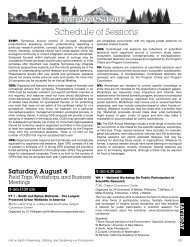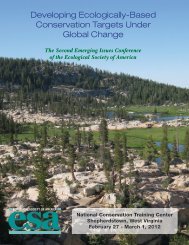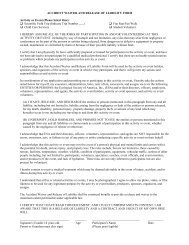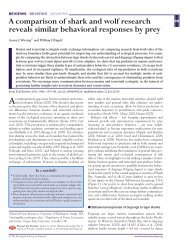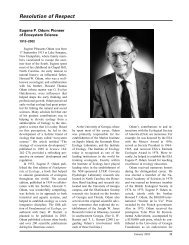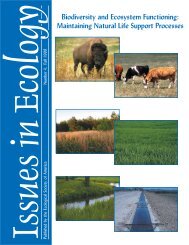Printed Program (PDF) - Ecological Society of America
Printed Program (PDF) - Ecological Society of America
Printed Program (PDF) - Ecological Society of America
Create successful ePaper yourself
Turn your PDF publications into a flip-book with our unique Google optimized e-Paper software.
THURSDAY<br />
8 am-11:30 am<br />
9:40 AM Break<br />
9:50 AM COS 143-6 Schaeffer, RN, JS Manson and RE Irwin,<br />
Dartmouth College. Microbial mediation <strong>of</strong> pollinator<br />
foraging behavior.<br />
10:10 AM COS 143-7 Essenberg, CJ, University <strong>of</strong> California-<br />
Riverside. Predicting the effects <strong>of</strong> flower density on<br />
pollinator species composition.<br />
10:30 AM COS 143-8 Roy, BA 1 , A Davis 1 , T Policha 1 , MR<br />
Barnadas 2 and BTM Dentinger 3 , (1)University <strong>of</strong> Oregon,<br />
(2)Magpie Studio: Fabrication for Art and Science,<br />
(3)Jodrell Laboratory Royal Botanic Gardens, Kew.<br />
Perceptual bias in floral mimicry: Visual cues.<br />
10:50 AM COS 143-9 Williams, NM 1 , E Lonsdorf 2 and J Forrest 1 ,<br />
(1)University <strong>of</strong> California, Davis, (2)Chicago Botanic<br />
Garden. Life history and resource distributions determine<br />
bee sensitivity to landuse change.<br />
11:10 AM COS 143-10 DeVan, CM and DE Bunker, New Jersey<br />
Institute <strong>of</strong> Technology. Pollinator species richness is<br />
correlated to flowering plant richness: A meta-analysis.<br />
COS 144 - Species Interactions II<br />
B117, Oregon Convention Center<br />
8:00 AM COS 144-1 Machnicki, NJ, C Adams and J Tewksbury,<br />
University <strong>of</strong> Washington. Generalist vs. specialist<br />
pathogens: Consequences <strong>of</strong> insect vectoring <strong>of</strong> fungal<br />
pathogens in wild chili peppers.<br />
8:20 AM COS 144-2 McIntire, EJB1 and A Fajardo2 , (1)Natural<br />
Resources Canada & Laval University, (2)Centro de<br />
Investigacion en Ecosistemas de la Patagonia. Moving<br />
facilitation out <strong>of</strong> its niche: Tree merging, supertrees, and<br />
the limits to the stress-gradient hypothesis.<br />
8:40 AM COS 144-3 Long, EY and DL Finke, University <strong>of</strong> Missouri.<br />
Predator diversity affects vector abundance and movement:<br />
Conflicting implications for pathogen prevalence?.<br />
9:00 AM COS 144-4 Kortessis, N and CT Lee, Florida State<br />
University. Consumer responses to resource density affect<br />
species coexistence in consumer-resource systems.<br />
9:20 AM COS 144-5 Kartzinel, TR, RP Shefferson and DW Trapnell,<br />
University <strong>of</strong> Georgia. Phylogeographic structure <strong>of</strong><br />
the Neotropical epiphytic orchid Epidendrum firmum<br />
corresponds to differences in symbiotic fungal communities.<br />
9:40 AM Break<br />
9:50 AM COS 144-6 Grinath, JB, BD Inouye and NC Underwood,<br />
Florida State University. Cascading effects from bears to<br />
plants via a protection-service mutualism.<br />
10:10 AM COS 144-7 Apple, JL1 , SL Lewandowski2 , SA Dzara1 ,<br />
DD Kane1 , JL Levine1 and BE Neary3 , (1)SUNY Geneseo,<br />
(2)University <strong>of</strong> Massachusetts Medical School, (3)<br />
University <strong>of</strong> Rochester Medical Center. Dynamics <strong>of</strong><br />
interactions between slavemaking ants and their hosts:<br />
Spatial, temporal, and genetic patterns.<br />
10:30 AM COS 144-8 Clause, J1 , B Richard1 , S Barot2 , T Decaëns1 ,<br />
M Legras3 and E Forey1 , (1)Laboratoire ECODIV,<br />
Université de Rouen, (2)IRD, Bioemco, (3)BioSol, Esitpa<br />
- Ecole d’Ingénieurs en Agriculture. Seed performances<br />
from casts <strong>of</strong> different earthworm species and different<br />
soil types.<br />
10:50 AM COS 144-9 Brody, AK, JB Gonzalez and GL Clarke,<br />
University <strong>of</strong> Vermont. Neither floral nor fungal<br />
mutualists help to explain the persistence <strong>of</strong> females in a<br />
gynodioecious plant.<br />
8:20 AM COS 145-2 Popescu, VD 1 , P de Valpine 2 , D Tempel 3<br />
and MZ Peery 4 , (1)University <strong>of</strong> California Berkeley,<br />
(2)University <strong>of</strong> California - Berkeley, (3)University<br />
<strong>of</strong> Minnesota, (4)University <strong>of</strong> Wisconsin - Madison.<br />
Estimating population impacts via dynamic occupancy<br />
analysis <strong>of</strong> Before-After Control-Impact studies.<br />
8:40 AM COS 145-3 Forcino, FL and LR Leighton, University <strong>of</strong><br />
Alberta. Sample size requirements for detecting change<br />
in abundance-based taxonomic composition.<br />
9:00 AM COS 145-4 Harris, DJ, UC Davis. Interpretable, accurate<br />
predictions <strong>of</strong> species distributions and community<br />
composition: Making the most <strong>of</strong> prior information.<br />
9:20 AM COS 145-5 Knape, J, K Scranton and P de Valpine,<br />
University <strong>of</strong> California - Berkeley. Estimating stage<br />
durations from samples <strong>of</strong> cohorts.<br />
9:40 AM Break<br />
9:50 AM COS 145-6 Anderson, MJ and DCI Walsh, Massey<br />
University. How does heterogeneity <strong>of</strong> multivariate<br />
dispersions affect ANOSIM, PERMANOVA, and the<br />
Mantel test?.<br />
10:10 AM COS 145-7 Finn, JT 1 , ME Mather 1 , MK Burak 1 , RM Muth 1 ,<br />
J Kim 2 and M Sutherland 1 , (1)University <strong>of</strong> Massachusetts,<br />
(2)USDA Forest Service Pacific Northwest Research<br />
Station. Evaluating new approaches to modeling data<br />
sets with many zeros: An example using anadromous fish<br />
counts.<br />
10:30 AM COS 145-8 Calabrese, J 1 , T Mueller 2 , P Leimgruber 1<br />
and WF Fagan 2 , (1)Smithsonian Conservation Biology<br />
Institute, (2)University <strong>of</strong> Maryland. Quantifying<br />
movement coordination among simultaneously tracked<br />
animals.<br />
10:50 AM COS 145-9 Hoeksema, JD 1 and JD Bever 2 , (1)University<br />
<strong>of</strong> Mississippi, (2)Indiana University. How should we use<br />
meta-analysis to answer complex questions in ecology<br />
and evolution?.<br />
11:10 AM COS 145-10 Cade, BS, U. S. Geological Survey.<br />
Estimating and comparing allometric growth <strong>of</strong> body<br />
mass with length using quantile regression.<br />
COS 146 - Trophic Dynamics And Interactions II<br />
C123, Oregon Convention Center<br />
8:00 AM COS 146-1 Hanlon, SM<br />
COS 145 - Statistics<br />
C120, Oregon Convention Center<br />
8:00 AM COS 145-1 McCune, B and HT Root, Oregon State<br />
148<br />
University. Nonparametric constrained ordination.<br />
ESA 97th Annual Meeting, August 5 - 10, 2012, Oregon Convention Center<br />
1 , J Kerby2 and M Parris1 , (1)<br />
University <strong>of</strong> Memphis, (2)University <strong>of</strong> South Dakota.<br />
The pesticide enigma: Varying effects <strong>of</strong> a fungicide and<br />
chytrid fungus on Southern Leopard frogs.<br />
8:20 AM COS 146-2 Ripple, WJ and R Beschta, Oregon State<br />
University. Large predators and trophic cascades in the<br />
<strong>America</strong>n West.<br />
8:40 AM COS 146-3 de Roos, AM1 , T Schellekens2 and L<br />
Persson3 , (1)University <strong>of</strong> Amsterdam, (2)Wageningen<br />
University Research, (3)Umeå university. Ontogenetic<br />
asymmetry in energetics overturns basic ecological<br />
principles.<br />
9:00 AM COS 146-4 Mitchell, SR1 , N Christensen1 , JR Walters2 ,<br />
K Palmquist3 , M Bertone4 and S Cohen5 , (1)Duke<br />
University, (2)Virginia Polytechnic Institute and State<br />
University, (3)University <strong>of</strong> North Carolina, (4)North<br />
Carolina State University, (5)Marine Corps Base Camp<br />
Lejeune. Soil properties drive differences in taxonomic<br />
groups among pine forests <strong>of</strong> the Atlantic coastal plain.<br />
9:20 AM COS 146-5 Granados, M1 , S Plourde2 and GF<br />
Fussmann1 , (1)McGill University, (2)Fisheries and<br />
Oceans Canada. Weakness is a strength: An empirical<br />
test <strong>of</strong> the weak interaction hypothesis in a food web<br />
with omnivory.<br />
9:40 AM Break


